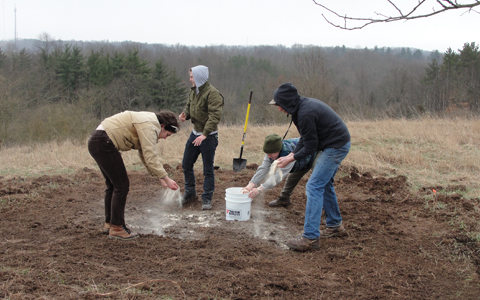Will Ohio University Plant Biology students bring colorful wildflowers and biodiversity to Radar Hill, planting seeds on a pasture-like hilltop little changed over the decades?
“One of the problems is there aren’t seeds up there, and it’s not like good plants are going to get up on Radar Hill, invasive or otherwise,” said Dr. Jared DeForest, Associate Professor of ecosystem and soil ecology in the College of Arts and Sciences. “This project is the start of providing that gene pool and increasing the biodiversity of Radar Hill.”
Students in Restoration Ecology (PBIO 3/5330) spent spring 2013 on a biodiversity project on Radar Hill, a site on The Ridges. Instead of having a lecture each class, the students apply class principles in the field on Mondays, gaining real-world experience in restoration ecology methods.
The project’s main goal is to increase biodiversity on Radar Hill by introducing and maintaining plant species in the area. In order to become a prairie, the area must be able to maintain grasses and herbaceous plants rather than primarily tree growth.
“The species we really went for are big blue stem, purple coneflower and butterfly weed,” said DeForest. “Students still had free rein to an extent, but butterfly weed already grows on the hill. These plants are also the dominant species of a prairie.”
The class maintained their plots through manual labor, using rakes and shovels to dig trenches, distributing seeds by hand and even getting on their hands and knees to clear away invasive grasses. They worked through all types of weather this semester, from heavy snowfall and pouring rain to warm, sunny days. DeForest merely observes the students’ work and makes occasional suggestions.
Junior Kyle Grubbs said that this project is a great experience for what he wants to do after he graduates from OHIO.
“I was interested in restoration ecology as a career so I thought that this course and project would be a good fit for me,” said Grubbs. “It’s been a cool class to be out in the field for too.”
DeForest developed the idea for the project for his through personal experiences working on Radar Hill. He noticed that most plants there were consumed by deer or were not supported by the soil and weather conditions on the hill. DeForest said that the area would not diversify on its own and thus developed the project, with financial support from the Plant Biology Department, to do so.
The project is expected to span several semesters and years of DeForest’s Restoration Ecology courses. Once this semester’s students move on, the next group of students will track the plots’ progress and gather the seeds from these plots to spread all over Radar Hill. Each plot will have a plaque that will tell future students what seeds and plants are located there.
“This is just the start,” said DeForest. “With this being the first time we’ve done this project, it’s just an experiment. Some things might work or might not. That’s what restoration is though—you just do it and see what happens.”
“There may be some results early on depending on the weather, but it will be at least a year to fully see visible growth and what worked or didn’t,” said graduate student Ryan Dorkoski.
When asked if she would come back and check on the progress of the project in the future, sophomore Shannon Walzer-Kuharic said she might, “just to see how the plants are progressing and spreading.”
Read Kristyn Repke’s article in Compass.



















Comments